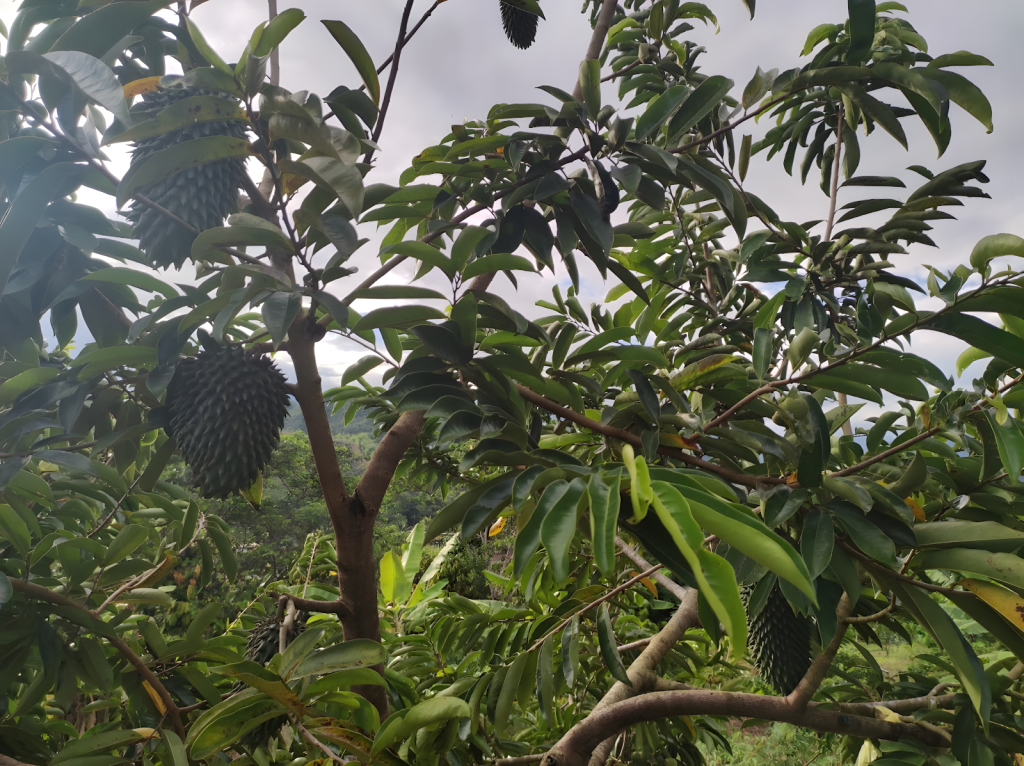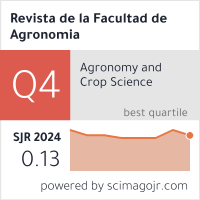Physicochemical characterization of Annona muricata L., fruits in Junin, Peru
Abstract
Soursop (Annona muricata L.) is an exotic fruit with high international demand, valued for its flavor, nutritional properties, and applications in the food industry. In Peru, its use includes fresh consumption and the production of pulp, nectars, and nutraceutical products. The objective of this study was to evaluate the physicochemical characteristics of fruits from selected soursop plants grown at the San Ramón Agricultural Experimental Station in the Department of Junín, Peru. The physical characteristics (fruit mass, polar and equatorial diameter), chemical characteristics (titratable acidity, ionic acidity, total soluble solids, and maturity index), as well as mineral content (phosphorus, magnesium, and calcium) were determined from the fruits. A completely randomized experimental design (CRD) and analysis of variance (ANOVA) were applied. The results showed that the FRCUNCP_09 and FRCUNCP_12 genotypes had the largest fruit mass (2.49 and 2.16 kg, respectively). On the other hand, the FRCUNCP_08, FRCUNCP_09, and FRCUNCP_12 genotypes presented optimal values of titratable acidity (0.8367, 0.9900, 1.1133), ionic acidity (3.99, 4.16, 3.62), and total soluble solids (16.5, 15.9, 17.7 BRIX), suitable for direct consumption and industrial processing. Regarding mineral content, FRCUNCP_09 had the highest concentrations of phosphorus (23,135 mg.100 g-1) and calcium (6,200 mg.100 g-1), while FRCUNCP_08 stood out for its magnesium content (21,604 mg.100 g-1). It is concluded that these materials have potential for genetic improvement programs and the development of nutraceutical products.
Downloads
References
Alomia-Lucero, J., Atao-Surichanqui, E., & Erazo-Toscano, E. (2022). Prendimiento y crecimiento de injertos en plantones de guanábana (Annona muricata L.), en Satipo – Perú. Revista Agrotecnológica Amazónica, 2(1), e252–e252. https://doi.org/10.51252/RAA.V2I1.252
AOAC. (2016). Association of Official Analytical Chemists. Official Methods of Analysis of AOAC International. 20(1). https://search.worldcat.org/title/1022575564
AOAC. (2019). Association of Official Analytical Chemist. Official Methods of Analysis of Association of AOAC International. https://es.scribd.com/document/490375550/Metodos-oficiales-de-analisis-21a-edicion-2019-AOAC-International
Arrazola-Paternina, G. S., Barrera-Violeth, J. L., & Villalba-Cadavid, M. I. (2013). Determinación física y bromatológica de la guanábana cimarrona (Annona glabra L.) del departamento de Córdoba. Orinoquia, 17(2), 153–160. http://www.scielo.org.co/scielo.php?script=sci_arttext&pid=S0121-37092013000200002
Ávila de Hernández, R., Pérez de Camacaro, M., Giménez, A., & Hernández Caraballo, E.A. (2012). La guanábana: Una materia prima saludable para la industria de alimentos y bebidas. Revista Digital de Investigación y Postgrado, 2 (2), 135-142. https://dialnet.unirioja.es/servlet/articulo?codigo=4204951
Coria-Téllez, A. V., Montalvo-González, E., Yahia, E. M., & Obledo-Vázquez, E. N. (2018). Annona muricata: A comprehensive review on its traditional medicinal uses, phytochemicals, pharmacological activities, mechanisms of action and toxicity. Arabian Journal of Chemistry, 11(5), 662–691. https://doi.org/10.1016/J.ARABJC.2016.01.004
Durán Agüero, S., Carrasco Piña, E., & Araya Pérez, M. (2012). Alimentación y diabetes. Nutrición Hospitalaria, 27(4), 1031-1036. https://pesquisa.bvsalud.org/portal/resource/pt/ibc-106245
Fernández, V., Sulbarán, B., Ojeda, G., Rodríguez, D. E., Nava, R., Delgado, J., Berradre, M., & Peña, J. (2007). Contenido mineral de la guanábana (Annona muricata L.) cultivada en el occidente de Venezuela. Boletín Del Centro de Investigaciones Biológicas, 41(1), 86–95. https://produccioncientificaluz.org/index.php/boletin/article/view/93
Fuenmayor, M., Ettiene, G., Pérez-Pérez, E., & Raga, J. (2016). Efecto de la forma de propagación y la frecuencia de fertilización nitrogenada sobre la actividad antioxidante en frutos de guanábana (Annona muricata L.). Revista De La Facultad De Agronomía De La Universidad Del Zulia, 33(2). Retrieved from https://produccioncientificaluz.org/index.php/agronomia/article/view/27196
Jiménez-Zurita, J. O., Balois-Morales, R., Alia-Tejacal, I., Juárez-López, P., Sumaya-Martínez, M. T., & Bello-Lara, J. E. (2016). Caracterización de frutos de guanábana (Annona muricata L.) en Tepic, Nayarit, México. Revista Mexicana de Ciencias Agrícolas, 7(6), 1261–1270. https://doi.org/10.29312/remexca.v7i6.175
Jiménez-Zurita, J. O., Balois-Morales, R., Alia-Tejacal, I., Sánchez Herrera, L. M., Jiménez-Ruiz, E. I., Bello-Lara, J. E., García-Paredes, J. D., & Juárez-López, P. (2017). Cold storage of two selections of soursop (Annona muricata L.) in Nayarit, Mexico. Journal of Food Quality, 2017, Article 4517469. https://doi.org/10.1155/2017/4517469
Kome, G. K., Enang, R. K., Silatsa, F. B. T., Yerima, B. P. K., Ranst, E. Van, Kome, G. K., Enang, R. K., Silatsa, F. B. T., Yerima, B. P. K., & Ranst, E. Van. (2024). Baseline edaphic requirements of soursop (Annona muricata L.). Tropical Plants, 3, E022. https://doi.org/10.48130/TP-0024-0023
León Méndez, G., Granados Conde, C., & Osorio Fortich, M. del R. (2016). Caracterización de la pulpa de Annona Muricata L. cultivada en el Norte del Departamento de Bolivar - Colombia. Revista Cubana de Plantas Medicinales, 21(4), 1–9. http://scielo.sld.cu/scielo.php?script=sci_arttext&pid=S1028-47962016000400012
Ministerio Nacional de Salud-Instituto Nacional de Salud (MINSA). (2009). Tablas peruanas de composición de alimentos. 843_MS-INS77 PDF. bvs.minsa.gob.pe
Ministerio de Desarrollo Agrario y Riego (MIDAGRI). (2024). Anuario estadístico de producción agroindustrial alimentaria 2023. Dirección General de Estadística, Seguimiento y Evaluación de Políticas. https://repositorio.midagri.gob.pe/handle/20.500.13036/1747
Moreira, R., Moreno, J., Buitrón, J., Orbe, K., Héctor-Ardisana, E., Uguña, F., & Viera, W. (2018). Characterization of soursop population (Annona muricata L.) from the central region of Ecuadorian littoral using ISSR markers. Vegetos, 31(3), 13-18. https://doi.org/10.5958/2229-4473.2018.00067.8
Nolasco-González, Y. M., Hernández-Montiel, L. G., & López-López, G. G. (2019). Caracterización morfológica y fisicoquímica de frutos de accesiones de guanábanas seleccionadas en Nayarit. Revista Mexicana de Ciencias Agrícolas, 10(23), 229–240. https://www.researchgate.net/publication/335670310
Norma Técnica Peruana. (NTP). (2009). NTP-203.110-2009-Jugos-néctares-frutas PDF https://es.scribd.com/document/478854661/NTP-203-110-2009-JUGOS-NECTARES-BEBIDAS-frutas-pdf-1-1-docx#:~:text=BEBIDAS %2Dfrutas %20PDF-,Este %20documento %20establece %20los %20requisitos %20para %20jugos %2C %20n %C3 %A9ctares %20y %20bebidas, %2C %20requisitos %2C %20muestreo %20y %20rotulado
Ojeda de Rodríguez, G., Coronado, J., Nava, R., Sulbarán, B., Araujo, D., & Cabrera, L. (2007). Caracterización fisicoquímica de la pulpa de la guanábana (Annona muricata L.) cultivada en el occidente de Venezuela. Boletín del Centro de Investigaciones Biológicas, 41(2), 151–160.
https://www.researchgate.net/publication/284705114_Caracterizacion_fisicoquimica_de_la_pulpa_de_la_guanabana_Annona_muricata_L_cultivada_en_el_occidente_de_Venezuela
Onimawo, I.A. (2002). Proximate composition and selected physicochemical properties of the seed, pulp and oil of soursop (Annona muricata L.). Plant Foods for Human Nutrition, 57(2), 165–171. https://doi.org/10.1023/A:1015228231512
Tiencheu, B., Claudia Egbe, A., Ufuan Achidi, A., Tenyang, N., Flore Tiepma Ngongang, E., Tonfack Djikeng, F., Tatsinkou Fossi, B., Mastanjevic, K., & Lakshkumar Jani, B. (2021). Nutritional, Organoleptic and phytochemical properties of soursop (Annona muricata L.) pulp and juice after postharvest ripening. European Journal of Nutrition & Food Safety, EJNFS 13(1), 15-28. https://doi.org/10.9734/EJNFS/2021/V13I130342
Villarreal-Fuentes, J. M., Alia-Tejacal, I., Hernández-Salvador, M. A., Hernández-Ortiz, E., Marroquín-Agreda, F. J., Núñez-Colín, C. A., & Campos-Rojas E. (2020). In situ characterization of soursop (Annona muricata L.) in the Soconusco region, Chiapas, Mexico. Revista Chapingo Serie Horticultura, 26(3), 189-205. https://doi.org/10.5154/r.rchsh.2020.05.008

Copyright (c) 2025 Elizabeth Nely Paitan Anticona, Doris Marmolejo Gutarra, Karina Jessica Marmolejo Gutarra, Edith Rosana Huamán Guadalupe

This work is licensed under a Creative Commons Attribution-NonCommercial-ShareAlike 4.0 International License.


















